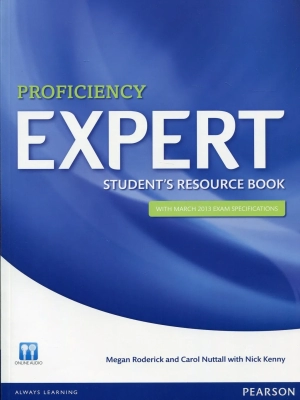Expert Proficiency Student’s Resource Book with Audio
Expert Proficiency Student’s Resource Book with Audio PDF,MP3

The Student’s Resource Book is an integral component of the Expert Proficiency course. It is designed to mirror the ten modules and themes found in the Coursebook and offers flexible usage options.
Uses of the Student’s Resource Book
It can be used:
- By teachers to supplement and extend Coursebook lessons.
- By students independently to consolidate, enrich language, and practise exam skills.
- As an intensive course, for example, during the final term before the exam.
Key Features and Content
- 10 modules aligned with the Coursebook.
- Each module includes:
- Extensive grammar practice in the Language development sections.
- Vocabulary consolidation and extension.
- Exam practice for Papers 1–3 (Reading & Use of English, Writing, Listening).
- A complete Practice Exam at the end of the book.
- Comes with an audio CD for listening tasks.
Expert Proficiency consists of:
- Coursebook for classroom use with audio CDs.
- Student’s Resource Book for homework, private study, or classroom use with audio CDs (available with or without Answer Key). This also includes one complete practice test.
- Teacher’s Resource Book (this book).
- Expert Proficiency Active Teach:
A standalone Interactive White Board component that includes PDFs of the Coursebook, Test Masters, and online teaching tools. It enables teachers to:- Present the course digitally in class.
- Access extra vocabulary games based on the coursebook wordlists.
Six Key Features of Expert Proficiency
- Flexibility in Course Structure
- Modular design allows teachers to follow the book’s sequence or create tailored lesson paths.
- Each (double) page spread is free-standing and follows a consistent structure across modules.
- Teachers can begin with any skill area (e.g., Speaking, Listening) or reorder the modules based on student interests.
- Linked Yet Independent Sections
- Sections can stand alone but are interconnected for coherent linear progression.
- Examples:
- ‘A’ unit Language development builds on previous Reading and Use of English tasks.
- Writing 1 supports Writing 2 in the ‘B’ unit.
- Speaking topics align with Listening content.
- ‘B’ unit Language development supports upcoming Writing.
- Expert Word Check: Vocabulary boxes with 10 key words from the Reading/Listening exam tasks.
- Teach–Test Approach in Language Development
- Focus on vocabulary and lexical grammar in the Language development section.
- Followed by Use of English tasks to test comprehension and application.
- Grammar reference and Student’s Resource Book offer further support and practice.
- Systematic Practice of Sub-skills
- ‘A’ units’ Listening 1 and Writing 1 sections train students in exam-relevant sub-skills:
- Listening: Understanding text structure, attitudes, and opinions.
- Writing: Register, planning, coherence, cohesion.
- ‘A’ units’ Listening 1 and Writing 1 sections train students in exam-relevant sub-skills:
- Process-Oriented Writing and Speaking
- ‘B’ units focus on building good habits and self-monitoring.
- Supports Papers 2 (Writing) and 4 (Speaking).
- Encourages student independence and skill development over simply producing correct answers.
- Expert Strategies for Exam Success
- Each section often includes an Expert Strategy box.
- These guide students on how exam tasks are structured.
- Aim to develop student autonomy and strategic thinking.
Contents
- Student’s Resource Book
- Audio
Format:PDF,MP3
Size: 140,53 MB
Edition: 1st Edition
Date: 2013
DOWNLOAD
Expert Proficiency Student’s Resource Book with Audio PDF,MP3
Related Posts
Expert Proficiency Coursebook with Audio
Expert Proficiency Teacher’s Resource Material